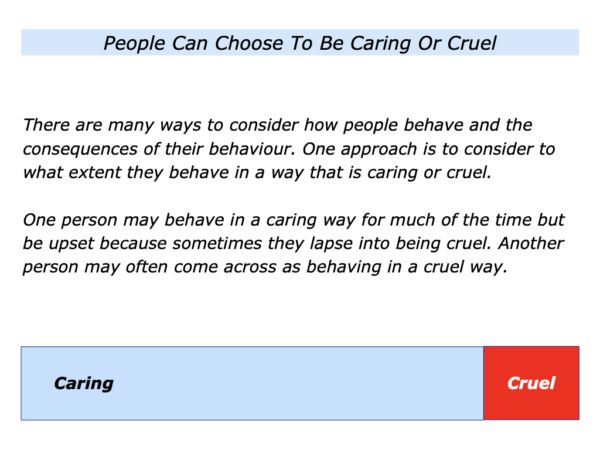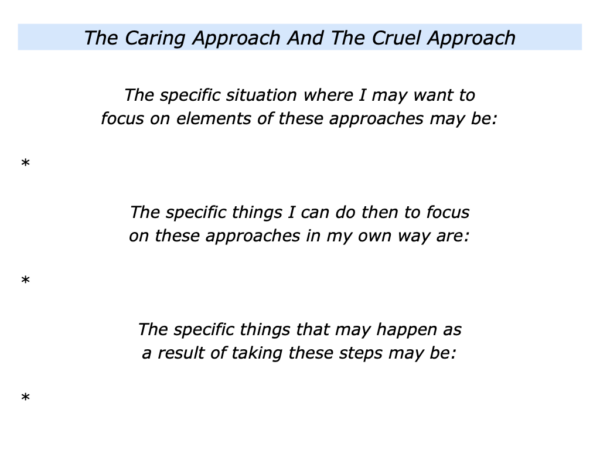
There are many ways to consider how people behave and the consequences of their behaviour. One approach is to consider to what extent they behave in a caring or cruel way.
Imagine that you are in a position where you may need to consider if a person behaves in these ways. Let’s explore some of the questions it may be useful to explore.
The Caring Approach
Many people aim to behave in a caring way. They aim to be kind, encouraging and help other people. They may translate this into action by caring for people or the planet.
Some people follow the caring approach in the daily lives as parents, partners or friends. Some follow it in their professional lives as teachers, medics, scientists, leaders, decision makers or in other roles.
Such individuals may behave in a caring or non-harmful way for more than ninety percent of their time. They may also recognise that sometimes they are not so kind and then try to improve their behaviour.
Imagine you are focusing on how a person behaves. This could be somebody you know or you are looking at from afar. One approach is to explore the following themes.
How does the person behave in a caring way? What percentage of their time do they behave in a caring or non-harmful way? How do they sometimes translate this into action?
Are there times when the person may behave in a harmful or cruel way? What percentage of their time do they behave in this way? Are they sometimes aware of this and try to improve their behaviour?
Imagine that you have focused on how a person demonstrates caring in their life or work. Sometimes you may also consider how another person behaves in different way.
The Cruel Approach
Some people follow the cruel approach. They may be unkind, dismissive or hurtful towards other people. The way they behave can cause pain or other kinds of collateral damage.
Some follow this approach in their personal lives. Some follow it in their working lives as politicians, managers, leaders or decision makers. The way they behave can have negative consequences.
Different people follow this approach for different reasons. Some may copy parents who were cold, mean or who spread fear. Some may want power and status. Some make sure that they win and other people lose.
Some may get a kick from being cruel. They enjoy hurting and insulting other people. Some may aim to get a cult following and scapegoat people who are different.
Imagine you are focusing on how a person behaves. This could be somebody you know or who you are looking at from afar. One approach is to explore the following themes.
What percentage of their time does the person appear to behave: a) in a caring or non-harmful way; b) in a cruel or hurtful way? How do they translate this into action? What are the consequences of their behaviour?
Let’s return to your own life and work. Looking ahead, can you think of a situation where you may want to focus on whether a person follows element of the caring or cruel approach?
You may want to do this when considering the behaviour of a person you know or who you are looking at from afar. There may be times when you may even want to focus on yourself.
If you wish, try tackling the exercise on this theme. This invites you to complete the following sentences.







Leave a Reply